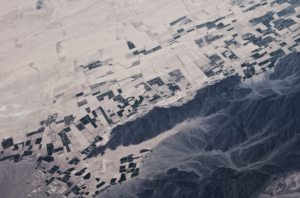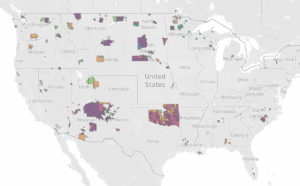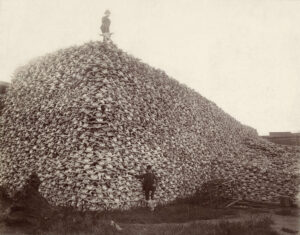The Native Lands Advocacy Project (NLAP) was founded in 2019 to provide much-needed data support to Native American communities. As a project of the nonprofit Village Earth, NLAP is inspired and guided by 30+ years of grassroots work in direct support of communities’ needs. Since NLAP’s inception, our work has been guided by the needs and priorities of Indian Country, and we’re proud to have developed over 120 free, public resources that empower sovereign tribal decision-making.
Tribal data needs are not trivial nor abstract. Like any other nation states, tribes require “accurate, relevant, and timely data for making decisions about their citizens, communities, and resources” (Carroll et al. 5). As part of the United States’ trust responsibility, and based on the treaties, laws, and court rulings that have shaped present-day Indian Country, the federal government has a moral and fiduciary obligation to provide this kind of data access, transparency, and control to tribes—especially data that can be used to assess its performance as a self-appointed Trustee. (Read more about NLAP’s commitment to Indigenous data sovereignty here, here, and here.)
However, data collected and maintained by the Bureau of Indian Affairs (BIA) and other federal entities are rarely accessible to Native communities or are published in burdensome formats that cannot be processed by tribes with smaller staff capacity. Data mismanagement and concealment create unnecessary barriers for tribes seeking to access their lands, manage their resources, and plan for the health of their communities. For example, lack of access to relevant data impedes tribes’ ability to complete their Agriculture Resource Management Plans, which would enable them to regain control over tribal agriculture. This is why, despite the AIARMA law itself being passed in 1993, so few tribes have been able to enforce their ARMPs through the Bureau of Indian Affairs.
These challenges can be further compounded by the ever-changing political climate in the United States, and the fact that most people, including public servants, have a limited knowledge of tribal law and Native land tenure, resulting in differing interpretations of the federal trust responsibility. As our political landscape changes, NLAP remains dedicated to serving Indian Country and partnering with organizations that share our values. This blog post articulates our ongoing commitments and current challenges. As a live post, we intend to update this as circumstances change.
Current Challenges & Our Responses
As a project of the 501(c)(3) nonprofit Village Earth, NLAP does not advocate for or against political candidates or seek to influence elections, as per the Johnson Amendment. Below, we seek only to share how recent policies affect our current work and commitments. To this end, we’re especially grateful to our partners at the Indigenous Food and Agriculture Initiative for their recent press release outlining the potential impacts of recent Executive Orders to Native food and agriculture.
Data Access
The recent deletion of federal webpages, removal of federal data (especially those related to climate), and agencies’ flagging of a variety of terms (including “indigenous communities,” “Native American,” and “tribal”) have raised concerns about public access to vital information and resources. For tribes, federal datasets—though limited—are often the main sources of relevant data about their lands, resources, and communities.
NLAP is closely monitoring the data sources used in our tools (some of which are federal, while others come from universities and other public research) to ensure that all of our resources remain live and accessible. Many of our datasets are downloaded and hosted internally or on our CKAN data portal, and we’re working to increase this remote hosting to ensure the resilience of our resources.
We’re also reassessing the priority-level of future data tools in light of these changes. For example, the deletion of federal environmental data makes it even more urgent for tribes to have access to other sources of relevant, accurate, and timely data to inform their climate planning. To this end, we will continue to update our Climate Data Portal for U.S. Native Lands with new data tools and informational resources to support tribal climate planning.
Finally, we are committed to uplifting the many data preservation efforts occurring in public, academic, and nonprofit circles. If you have suggestions about datasets that NLAP should host, data tools that we should develop, or adjustments that would optimize existing resources, please contact us.
Expand to view some of our key data resources for tribal communities
The Climate Data Portal for US Native Lands
A toolkit to support sovereign climate planning on Native Lands.
Data Tools for Native Farmers & Ranchers
Supporting Native farmers’ and ranchers’ informed decision-making.
DEI & Tribal Sovereignty
Tribal citizenship is a political designation, not a racial one (see Morton v. Mancari, 1974). Nonetheless, recent crackdowns on DEI/DEIA programs raise concerns that tribal programs, services, and staffing may be caught in the crossfires based on misunderstandings of the federal government’s relationship with tribal nations.
Now more than ever, it’s important that the public and our government officials understand the unique government-to-government relationship between the United States and individual tribes. The federal government’s support of tribal services is not altruism or generosity, nor is it preferential treatment; rather, it’s a legal mandate based on treaties and the U.S’ self-appointed responsibility as trustee of Native lands. According to Article VI of the U.S. Constitution, “treaties…shall be the supreme law of the land.” That the U.S. government has broken nearly every (if not every) treaty with Tribal Nations and failed to abide by its own laws does not change the fact that they are embedded in the country’s foundational documents. Because of this, calling into question tribal treaty rights is akin to questioning the legitimacy of the foundation of the U.S. as a nation.
NLAP’s data tools are designed with tribal priorities in mind and aimed at supporting tribal self-determination. In addition to producing data tools (maps and dashboards), we also present those data within their proper historical and present-day context for tribes. We remain committed to producing educational materials such as blog posts, storymaps, and webinars to (1) assist our users in accessing the data and information they need and (2) educate the public about the unique tribal contexts surrounding these data. NLAP will always uphold tribal sovereignty as the foundational principle in these conversations. For a practical example of this, see how we situated three of our fire-related data tools within tribal contexts and histories in our Good Fire storymap.
Expand to view key examples of how NLAP contextualizes data for tribal communities
Good Fire: Mitigating Wildfire Risk & Healing Native Lands
After a long history of fire suppression, Native communities are reintroducing good fire to their lands.
The Buffalo’s Resilience in the Face of Settler Colonialism
As Native nations reintroduce buffalo, their lands, ecosystems, and communities heal.
Quantifying Disparities in Agricultural Revenue on Native Lands
What factors contribute to the current and historical disparities in agricultural revenue on Native lands?
Funding & Resource Availability
Closely related to the above discussion is the conversation about funding. NLAP does not currently receive any federal funding, but recent freezes and recissions do raise questions about the availability of funds in the long-term for our work and that of our partners. These concerns reverberate throughout Indian Country, as layoffs and cuts affect tribal health, education, natural resource management, and more.
For NLAP, these concerns spark two different but connected conversations: internally, how we can maintain the funding needed to sustain our team and resources, and externally, how we can increase resilience by strengthening relationships and increasing our support to Indian Country.
Internal—sustaining our team:
Our day-to-day work deals directly with the real and lasting disparities experienced by Indigenous communities. We will continue to speak about climate science, marginalization, historical oppression, cultural differences, barriers/accessibility, and more, and we understand that this decision likely eliminates our chances of receiving federal funding. We had hoped to receive federal funding in the coming years as our work and team grow (even applying for a federal grant at the end of 2024), but to change our language around these important issues would be to obscure reality and compromise our mission. This is NLAP’s commitment; simultaneously, we understand and respect that every organization has to make difficult decisions in the interest of their work and the communities they serve.
We are now, more than ever, dependent on public support from organizations and individuals who believe in the value of our work. We’re thankful to our existing and growing relationships with grantmakers and funders who share our values. We’re also working to launch our sponsorship program, which allows organizations to pledge funds on an annual basis to support our work. If you’re interested in learning more about becoming a sponsor, please contact us (you can also email info@nativeland.info). If you’re interested in donating on a smaller scale to our work, you can make a one-time or recurring donation to NLAP or to our parent organization, Village Earth.
External—increasing resilience:
NLAP has always operated within what we call our “ecosystem of partners.” Our work is relational and has, from inception, been guided by the grassroots priorities of Indian Country. As our partners and relations adapt to policy changes, NLAP will continue building and maintaining strong networks of support and reciprocity. We’re committed to listening closely to tribal concerns, uplifting Native voices, and meeting data and support needs where we’re able.
While our work is remote, we average ten weekly meetings with existing and new partners, and we always encourage users of our site to contact us with any questions or potential collaborations. If you’re interested in building a relationship with NLAP, please contact us here. You can also follow our social media to keep up with our work.
In Conclusion
NLAP remains committed to empowering tribal sovereignty by creating access to the data tribes need to protect their lands and plan for the future. If you’d like to support us in this work, we invite you to follow us, join our newsletter (sign-up form at the bottom of this page), and consider making a one-time or recurring donation to keep our work free and open-access. If you’re interested in collaborating or becoming a sponsor of our work, please contact us here or at info@nativeland.info. And if you are already a partner or supporter of our work, we are so thankful for you!
Works Cited
American Indian Agricultural Resource Management Act (AIARMA), 25 U.S.C. Ch. 39 § 3701 (1993)
American Indian Higher Education Consortium. (2022). Legislative Priorities. Accessed on April 3, 2025 from https://www.aihec.org/legislative-priorities/
Brown, A. (2025, March 4). For Indian Country, federal cuts decimate core tribal programs. Stateline. https://stateline.org/2025/03/04/for-indian-country-federal-cuts-decimate-core-tribal-programs/
Carroll, S. R., Rodriguez-Lonebear, D., & Martinez, A. (2019, July 8). Indigenous Data Governance: Strategies from United States Native Nations. Data Science Journal, 18, Article 31. http://doi.org/10.5334/dsj-2019-031
Chesnais, A. K. (2022, September). The Double Data Movement towards the Ecological Pluriverse: The Case of the Native Land Information System. ResearchGate. https://www.researchgate.net/publication/364667210_The_Double_Data_Movement_towards_the_Ecological_Pluriverse_The_Case_of_the_Native_Land_Information_System
Data + Screening Tools. (n.d.). Public Environmental Data Partners. Accessed on April 3, 2025 from https://screening-tools.com/
Indian Land Tenure Foundation. (n.d.). Estate Planning. Accessed on April 3, 2025 from https://iltf.org/wp-content/uploads/2016/11/AIARMA.pdf
Indian Land Tenure Foundation. (2025). Treaty Signers Project. Accessed on April 3, 2025 from https://treatysigners.us/database/
Indigenous Food & Agriculture Initiative. (2025, March 27). IFAI Hosts Second Webinar on Executive Orders’ Impact on Tribal Food and Agriculture #2. Retrieved on April 5, 2025 from https://www.indigenousfoodandag.com/news/press-release/ifai-to-host-webinar-on-executive-orders-impact-on-tribal-food-and-agriculture-march/
McMullin, R. (2024, January 28). Amplifying Indigenous Data Sovereignty on National Data Privacy Day. Native Land Information System. https://nativeland.info/uncategorized/indigenous-sovereignty-on-national-data-privacy-day/
Morfitt, M., & Scheerer, E. (2024, April 3). Good Fire: Mitigating Wildfire Risk & Healing Native Lands. Native Land Information System. Accessed on April 3, 2025 from https://nativeland.info/storymaps/good-fire/
Morton v. Mancari, 417 U.S. 535 (1974)
Singer, E. (2025, February 2). Thousands of U.S. Government Web Pages Have Been Taken Down Since Friday. The New York Times. Accessed on April 3, 2025 from https://www.nytimes.com/2025/02/02/upshot/trump-government-websites-missing-pages.html
The Native Lands Advocacy Project (NLAP). (n.d.). About the Native Land Information System. Native Land Information System. Accessed on April 3, 2025 from https://nativeland.info/about/
The Native Lands Advocacy Project (NLAP). (n.d.). ARMP-IRMP Planning Portal. Native Land Information System. Accessed on April 3, 2025 from https://nativeland.info/data-portals/armp-irmp-data-portal/
The Native Lands Advocacy Project (NLAP). (n.d.). Contact Us. Native Land Information System. Accessed on April 3, 2025 from https://nativeland.info/contact/
The Native Lands Advocacy Project (NLAP). (n.d.). Data Sovereignty. Native Land Information System. Accessed on April 3, 2025 from https://nativeland.info/about/data-sovereignty/
The Native Lands Advocacy Project (NLAP). (n.d.). Native Lands Blog. Native Land Information System. Accessed on April 3, 2025 from https://nativeland.info/blog/
The Native Lands Advocacy Project (NLAP). (n.d.). Our History. Native Land Information System. Accessed on April 3, 2025 from https://nativeland.info/about/history/
The Native Lands Advocacy Project (NLAP). (n.d.). Storymaps. Native Land Information System. Accessed on April 3, 2025 from https://nativeland.info/storymaps/
The Native Lands Advocacy Project (NLAP). (n.d.). Welcome to the Native Land Data Portal. Native Land Information System. Accessed on April 3, 2025 from https://data.nativeland.info/
The Native Lands Advocacy Project (NLAP). (2024). Climate Data Portal for U.S. Native Lands. Native Land Information System. Accessed on April 3, 2025 from https://nativeland.info/data-portals/climate-data-portal-for-us-native-lands/
The Native Lands Advocacy Project (NLAP). (2025). Beacons. Accessed on April 3, 2025 from https://beacons.ai/nativelandsadv
The Native Lands Advocacy Project (NLAP). (2025). Support the Native Land Information System. Native Land Information System. Accessed on April 3, 2025 from https://nativeland.info/donate/
The Native Lands Advocacy Project (NLAP). (2025, February 24). Announcing our Webinar Series: Keystone Data Tools for Native Land Planning. Native Land Information System. Accessed on April 3, 2025 from https://nativeland.info/resources/announcing-our-webinar-series-keystone-data-tools-for-native-land-planning/
UCLA Office of Equity Diversity and Inclusion (EDI). (2025). Resources on Native American and Indigenous Affairs. Accessed on April 3 2025 from https://equity.ucla.edu/know/resources-on-native-american-and-indigenous-affairs/native-american-and-indigenous-peoples-faqs/
U.S. Department of the Interior Indian Affairs. (2017, November 8). What is the Federal Indian Trust Responsibility?. Accessed on April 3, 2025 from https://www.bia.gov/faqs/what-federal-indian-trust-responsibility
Vile, J. R. (2020, January 10). Johnson Amendment. Free Speech Center: at Middle Tennessee State University. Accessed on April 3, 2025 from https://firstamendment.mtsu.edu/article/johnson-amendment/
Village Earth. (2021). Welcome to Village Earth!. Accessed on April 3, 2025 fromhttps://villageearth.org/
Village Earth. (2025). Donate to Village Earth. Accessed on April 3, 2025 from https://villageearth.org/donation/
Yourish, K., Daniel, A., Datar, S., White, I., & Gamio, L. (2025, March 7). These Words Are Disappearing in the New Trump Administration. The New York Times. Accessed on April 3, 2025 from https://www.nytimes.com/interactive/2025/03/07/us/trump-federal-agencies-websites-words-dei.html
Originally Published
Originally published April 8, 2025.












